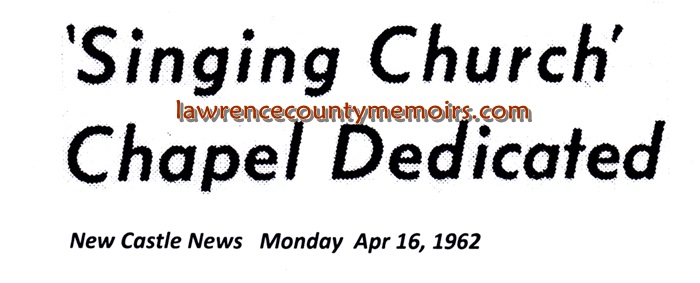In about 1804 a man named William Richards (1756-1839), a Revolutionary War veteran, settled with his family in what later became Neshannock Township, Lawrence County, Pennsylvania. He was among the first of a host of settlers the came from Bellafonte in Centre County, Pennsylvania. Before too long a traveling Methodist “circuit preacher” named Asa Shinn began holding services in Richards’ log cabin home, a few miles northwest of the new settlement of New Castle. Later meetings were held in another home and also a schoolhouse at the intersection of what became Old Pulaski Road and King’s Chapel Road. This was the first Methodist gathering established in territory encompassing Lawrence County.
Within a few years another early settler named Marinus King (1778-1857) built a small crude chapel for the growing congregation. The first wooden frame church, known as the Chenango (or Shenango) Methodist Episcopal Church, was erected with the assistance of King in 1835-36. In January 1937 King and his wife Elizabeth donated the property to the congregation. Years later the church was officially renamed in King’s honor – as the King’s Chapel Methodist Episcopal Church. A small cemetery had also been started as well, with a host of burials taking place in the 1830’s and 1840’s.
A larger church was built in 1856 and is known for the providing the start of two men noted for their musical ability. Ira D. Sankey (1840-1908), who had an amazing voice, sung in the choir here as a teenager until he moved to New Castle with his prominent family. He later teamed up with renowned evangelist Dwight L. Moody and sung religious hymns at revivals all across the country. Sankey became internationally famous as the “Sweet Singer of Methodism.” A young George Greer (1844-1926) attended services and sung in the choir as well until he moved on New Castle as a young man to start a business – with his brother Charles – selling pianos and organs. He sold that business in 1891 and subsequently organized the New Castle Sheet and Tin Plate Company, which launched a thriving industry of its own and helped put New Castle on the map. Greer was one of New Castle’s most prominent turn-of-the-century citizens – a powerful industrialist, a successful banker, an accomplished choir director, and a giving humanitarian.
Another new building, which cost $2,700, was dedicated at the same location in December 1899. By the turn of the century the church had a thriving and dedicated congregation that any pastor would envy. On Sunday, August 30, 1936, the day the congregation celebrated its 132rd anniversary, a memorial plaque was installed at the site to honor the church’s 1804 founding as well as the late Ira Sankey. The church was completely remodeled in 1949, but a decade later it was decided to erect a modern church. A new parsonage was dedicated on nearby Wallace Avenue in November 1959 on property donated by the Heckathorn family, and then the adjoining property along the Old Pulaski Road was purchased soon after. Construction of a new house of worship, which cost $125,000, began in July 1961 and was dedicated during a ceremony on Sunday, April 15, 1962. The Reverend Richard E. Hawke, the pastor from 1954-1964, oversaw the building program. The old church was vacated in the spring of 1962 but the cemetery remained in use. An effort was made to preserve the historic church, but it did not come to fruition and the building was torn within a few years.
The Methodist and Evangelical United Brethren Churches congregations were merged on a national level in April 1968 and as a result the name of the congregation was changed to the King’s Chapel United Methodist Church. The congregation, one of the oldest in the county, celebrated its 200th anniversary in 2004 and is still in active service today.
 The congregation of what later became known as King’s Chapel Methodist Church was founded in 1804. The members met at various locations – to include a small crude church – over the years until a permanent church building was erected in 1856. The land was donated by an early settler named Marinus King. That building was replaced with a newer church (shown above) in 1899 and it served the congregation for the next six decades. (c1930) (Photo courtesy of Sherry Slater) Full Size |
 King’s Chapel Methodist Church was named in honor of Marinus King (1778-1857), a Methodist settler who donated the land on which the original churches and cemetery were situated. (c1940) Full Size |
 A newer and more modern building was dedicated in April 1962 at a nearby location. The old church (shown above) was later razed but the cemetery that marks its former location is still in use today. (c1925) (Photo courtesy of Sherry Slater) Full Size |
 In the late 1950’s plans were put into place to build a new church just to the north on Old Pulaski Road & Wallace Avenue. In late 1959 a parsonage was opened at the new site and construction of the church (shown above) commenced in July 1961. The new building was completed and occupied in April 1962. In 1968, after a national reorganization, the congregation became known as the King’s Chapel United Methodist Church. The old church was later torn down. (Jul 2013) Full Size |
 |
 (Jul 2013) |  (Jul 2013) |
 (Jul 2013) Full Size |




Comments
Debbie Saul #
Looking for information on Circuit Rider preacher (1830) in Lawrence CO AK.
name is Henry Covington, hoping you would know where I could get information on him.
have information from Pleasant Grove United Methodist Church about him.
Thank you for any help..
Debbie
Comment